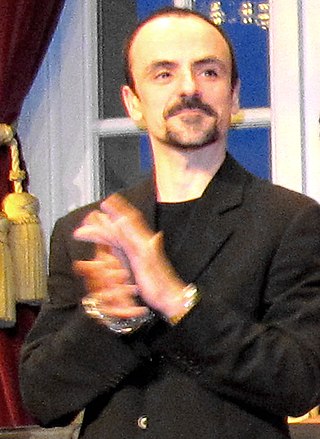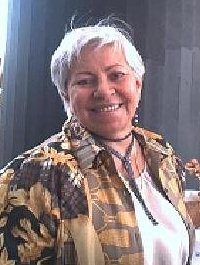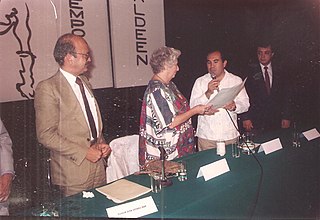Related Research Articles

The Cuban National Ballet is a classical ballet company based at Great Theatre of Havana in Havana, Cuba, founded by the Cuban prima ballerina assoluta, Alicia Alonso in 1948. The official school of the company is the Cuban National Ballet School.
Abigail Levine is a New York-based dance and performance artist. Levine has created works for opera and theaters--as well as for subway stations, sidewalks, swimming pools, airports, office buildings--in New York City, Washington DC, Havana, São Paulo, Mexico City, Caracas, and Taipei.

Viengsay Valdés is a Cuban ballerina. Since 2003, Valdés is the Prima ballerina and since 2019 she is the Artistic Director of the National Ballet of Cuba.

Igor Yebra Iglesias is a Spanish freelance ballet dancer.
Noralma Vera Arrata is a former Ecuadorian prima ballerina and choreographer.
Alberto Julio Rayneri Alonso was a Cuban dancer and choreographer, the brother of Fernando Alonso and brother-in-law of Alicia Alonso. He was influential in the development of the Cuban style of ballet, a combination of Russian and Western techniques with a Latin style.
Annabelle Lopez Ochoa is a Belgian-born international choreographer based out of Amsterdam, Netherlands.

Vicente Balbino Nebreda Arias was a choreographer and dancer who was considered a Venezuelan pioneer for dance during the 1940s. He was part of the Cátedra de Ballet del Liceo Andrés Bello, the first attempt at a formal dance school in the country. Later on, he danced with Ballet Nacional de Venezuela, the first long term professional company. Nebrada was also one of the first Venezuelan dancers to have an international career, he worked with Roland Petit’s company in France, the Joffrey Ballet, the Harkness Ballet in the United States, and Ballet Nacional de Cuba. His extensive career as a choreographer began in 1958, when he began his professional career, and ended with the creation of his version of The Nutcracker in 1996. He created 61 original choreographies and adaptations of universally classic repertoires for diverse companies all over the world.
Guillermina Nicolasa Bravo Canales was a Mexican modern dancer, choreographer and artistic director of Ballet Nacional de Mexico. She was co-founder of the academy of Mexican dance in 1947 and established together with Josefina Lavalle the national ballet company in Mexico City in 1948, which has been located in Querétaro since 1991, where she also established the national center of contemporary dance. Bravo is considered as main figure of modern Mexican dance. Her sister Lola (1918–2004) was a notable stage actress.

Daniel Sarabia is a Cuban ballet dancer with the Maurice Béjart Ballet of Lausanne, Switzerland.
Havana, Cuba, is a host city to numerous events and festivals.
Juan Piñera is a Cuban musician who during his long career has covered a wide professional spectrum as performer, composer, professor and musical adviser.
tumàka't Contemporary Dance is a Mexican contemporary dance troupe founded in 2007, under Vania Duran, which works to promote contemporary dance in southern Mexico.
Silvina Fabars is a Cuban folk dancer and ballerina who is the principal dancer of the National Folkloric Ensemble of Cuba and a noted folk dance instructor throughout Latin America and Europe. She has won numerous awards and recognition throughout her career including the Vanguardia Nacional, the Distinción por la Cultura Nacional, and the Alejo Carpentier Medal. In 2014, she was honored as the recipient of the National Dance Prize of Cuba.

Goyo Montero Morell is a Spanish ballet dancer, a ballet director and a choreographer.

La técnica cubana, often abbreviated as técnica, is a form of Cuban contemporary dance that was founded by Ramiro Guerra Suarez in Cuba in 1959. Unlike other forms of traditional Cuban dance, técnica fuses many different dance forms together, such as those from Africa, Europe, and North America. It is a highly expressive and robust dance form, incorporating many quick jumps and undulating movements of the torso and pelvis. Técnica blends a high amount of movement and expression with a degree of synchronization, producing an athletic, theatrical dance form.

Irma Contreras is a former dancer, choreographer, and ballet teacher. She is part of the 1940s generation of Venezuelan dancers. She created and founded the National Ballet of Venezuela with her sister Margot Contreras.

Zhandra Rodríguez is a Venezuelan ballet dancer, choreographer, founder of the Caracas International Ballet, and founder and director of the New World Ballet of Caracas.

The José Limón National Contemporary Dance Award is a Mexican modern and contemporary dance award established in 1988 and named in honor of the dancer and choreographer José Limón. It is granted by the National Council for Culture and the Arts (CONACULTA) and the government of the state of Sinaloa. Due to its age and significance, it is considered the country's most important dance award.
Lorna Burdsall was an American dancer and choreographer who was a founding member and director of the Danza Contemporanea de Cuba. From 1955 to 1975, she was married to Cuban intelligence official Manuel Piñeiro. Following her divorce from Piñeiro, Burdsall became the National Director of Dance and Modern Dance in Cuba, and was an advisor on modern dance to Cuba's Minister of Culture.
References
- ↑ [ permanent dead link ] Pedro de la Hoz. "Ramiro Guerra a los 90: eterno, lúcido, fundador", Granma, 29 June 2012
- Enchanted by Cuba: Dance Magazine's editor in chief, Wendy Perron, travels to Havana for its International Ballet Festival. Dance Magazine, March, 2007 by Wendy Perron
- Video interview of Miguel Iglesias director of Danza Contemporanea de Cuba Company on Havana-Cultura
- Cuba Absolutely – Music and Dance - Cuba Dance – Cuban Danza Contemporary Company
- SkyArts – Carlos Acosta and the Danza Contemporanea de Cuba. Reviewed by Ian Palmer
- New York Public Library – Exhibition: Dance in Cuba